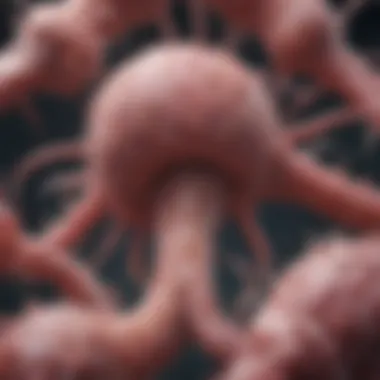Exploring the Role of KRAS Wild Type in Cancer


Intro
The KRAS gene has emerged as a significant player in the field of cancer biology, especially when we discuss its wild type version. Understanding the nuances of KRAS wild type provides invaluable insights into how various cancers develop and respond to treatment. KRAS, an oncogene situated on the short arm of chromosome 12, codes for a protein involved in cellular signaling. However, it's the distinctions between KRAS wild type and its mutated forms that hold crucial implications for cancer research and therapy.
In this exploration, we will journey through the biological and clinical realms related to KRAS wild type. This includes shedding light on its role in signaling pathways, the impact of mutations, and a broader view on how these elements contribute to cancer treatment strategies. By deciphering intricate mechanisms and current studies surrounding KRAS, we aim to enhance comprehension for a diverse audience—ranging from medical professionals to curious individuals interested in genomics.
As we unfold the layers of KRAS wild type, it’s vital to highlight the recent progress in this field, exploring how emerging discoveries and technological advancements are shaping our understanding. Each segment of this work will build upon the last, creating a clear path from basic concepts to complex clinical implications.
Preamble to KRAS
The topic of KRAS is pivotal in the study of cancer biology, particularly as it relates to understanding the nuances of oncogenes and their mutations. KRAS, short for Kirsten rat sarcoma viral oncogene homolog, plays a crucial role in cell signaling, which ultimately informs cellular growth and differentiation. Recognizing how this gene operates, especially in its wild type form, is essential for grasping broader concepts in cancer research and therapy.
When we talk about KRAS, we're diving into a realm that significantly influences treatment decisions and prognoses for various cancers. This understanding is not merely academic; it directly impacts patient care and outcomes. With the rise of personalized medicine and targeted therapies, comprehending the wild type variant of KRAS becomes ever more urgent for healthcare professionals, researchers, and informed individuals alike.
Key considerations that enrich our comprehension include:
- The distinct functions of wild type KRAS compared to its mutant forms
- The pathways through which KRAS operates, influencing cancer progression
- The implications of KRAS status for selecting appropriate treatments
- Ongoing research that continues to evolve our understanding of its role in cancer biology
Understanding KRAS in its entirety, therefore, provides a thoughtful framework for unraveling the complexities of cancer mechanisms. It allows those engaged in the field—from students to seasoned researchers—to ground their knowledge in this foundational gene's significance as they navigate the landscape of oncology.
What is KRAS Wild Type?
Understanding the concept of KRAS wild type is crucial in the broader context of cancer biology and treatment. KRAS is a gene that plays a significant role in the regulation of cell division. When examining KRAS, distinguishing between the wild type and its mutant variants becomes essential, as they correlate directly with tumor behavior, treatment response, and overall patient prognosis.
The wild type shows no mutation; it's the standard form of the KRAS gene. In contrast, mutations in KRAS—often seen in many cancers like pancreatic, colorectal, and lung cancer—lead to continuous activation of signaling pathways that drive uncontrolled cell proliferation. The implications for cancer treatment are substantial, as therapies targeting mutated KRAS may differ significantly from those used when KRAS remains wild type.
Description of Wild Type
The KRAS wild type is the unaltered version of the KRAS gene, which encodes a protein involved in important cell signaling pathways. This gene is known for being a critical player in signal transduction, facilitating epidermal growth factor receptor signaling, among others. The wild type operates normally, allowing cells to respond appropriately to external signals. In essence, the wild type can be seen as the 'baseline'—it dictates normal functions like cell survival, differentiation, and growth.
From a molecular standpoint, the KRAS wild type functions by regulating several downstream processes; it activates proteins that control various cellular activities. When it operates correctly, signaling cascades are initiated that promote normal cellular function. Without mutations to spur aberrant activation, the KRAS wild type helps maintain cellular homeostasis. This state is a stark contrast to the downstream effects of mutant forms, which can lead to oncogenesis and cancer progression.
Comparison with KRAS Mutant Forms
The distinction between KRAS wild type and its mutant forms cannot be overstated. Here’s a closer look at these differences:
- Functionality:
- Cancer Types:
- Treatment Implications:
- Wild type KRAS functions normally, responding appropriately to growth signals.
- Mutated KRAS variants result in a protein that is constitutively active, leading to sustained signaling even in the absence of stimuli.
- Wild type KRAS is typically associated with a better prognosis and more effective responses to certain treatments.
- Mutant KRAS is frequently linked to aggressive cancers and poor responsiveness to standard therapies, often leading to reliance on alternative treatment strategies.
- In the presence of KRAS wild type, patients may benefit from standard chemotherapy regimens, and recent findings suggest combinations with immunotherapies could enhance outcomes.
- Conversely, the presence of KRAS mutations typically necessitates different therapeutic approaches, which could exclude some standard treatments due to resistance mechanisms.
With this understanding, it becomes evident why the characterization of KRAS as either wild type or mutant is a pivotal component in cancer diagnostics and treatment planning.
“Identifying the KRAS status is not just about knowing the presence of a mutation; it’s about selecting the right path forward in cancer treatment.”


Biological Role of KRAS
The role of KRAS in biological systems extends far beyond its simple definition. It’s like the wind that carries seeds across a field; without it, certain biological processes wouldn’t even take root. When examining tumor biology, KRAS stands out due to its classification as an oncogene. Understanding its mechanics can help in demystifying the complexities that underpin cancer proliferation.
KRAS as an Oncogene
KRAS functions as a central player in signaling networks that dictate cell growth and division. This protein, along with its well-known mutations, acts as a switch determining whether cells proceed to divide or remain static. When KRAS behaves normally, it regulates essential cellular functions. However, mutations turn the dial in an unintended direction, compelling cells to divide incessantly. Essentially, this misguided behavior can initiate a cascade that leads to tumor genesis.
The influence of KRAS as an oncogene entails a myriad of downstream effects. Early research pinpoints KRAS mutations in several types of malignancies, with pancreatic cancer being a standout. Studies indicate that over 90% of pancreatic tumors harbour KRAS mutations. This significant correlation underscores the oncogenic potential embedded in KRAS signaling.
Signaling Pathways Involving KRAS
The pathways associated with KRAS are paramount to understanding how this oncogene contributes to cancer biology. Specifically, the MAPK and PI3K pathways emerge as two vital conduits that KRAS engages. Let’s delve deeper into the specifics of each pathway.
MAPK Pathway
The MAPK pathway, or Mitogen-Activated Protein Kinase pathway, is renowned for its role in regulating cell proliferation and survival. At its core, this pathway processes signals from the surface of the cell to the nucleus. KRAS acts as a pivotal link in this chain, relaying growth signals that can either promote cell growth or trigger apoptosis when necessary.
If one examines the unique features of the MAPK pathway, it comes down to its responsiveness; it promptly reacts to external stimuli like growth factors. This characteristic makes it a popular topic of interest within oncological research, especially when unraveling treatment strategies targeting KRAS-driven tumors. However, a double-edged sword exists: the fast responses can lead to aberrations in cell signaling, creating persistence in growth signals that are instrumental in chronic diseases, including cancer.
PI3K Pathway
The PI3K pathway, otherwise known as the Phosphoinositide 3-kinase pathway, interfaces closely with KRAS signaling and is crucial for cell survival and metabolism. When activated, PI3K can enhance cellular growth and resistance to programmed cell death. Herein lies a critical aspect — dysregulation of this pathway also reveals itself in diverse cancers, particularly breast and colorectal.
One unique feature of the PI3K pathway is its ability to orchestrate cellular responses that affect metabolism significantly. It holds prominence as it presents potential therapeutic targets, yet targeting this pathway can be intricate. While it has advantages in aiding traditional therapies, concerns linger regarding the pathway’s role in engendering resistance to treatments aimed at KRAS.
Clinical Implications of KRAS Wild Type
The clinical implications of KRAS wild type status are pivotal in the field of oncology today. Recognizing the implications of this genetic marker affects treatment strategies, patient management, and prognostic assessments. For oncologists and cancer researchers, understanding KRAS wild type is not merely an academic exercise; it informs the potential efficacy of therapies and shapes decisions about patient care. In a landscape crowded with treatment options, KRAS wild type presents a unique lens through which the treatment landscape can be examined.
Impact on Cancer Treatment
Immunotherapy Considerations
When it comes to immunotherapy, KRAS wild type status plays a significant role in shaping treatment plans. Particularly, immune checkpoint inhibitors have garnered a lot of traction in recent years. These agents, like pembrolizumab, hinge upon the capability of a patient’s immune system to detect and attack tumors. KRAS wild type tumors often express higher levels of antigens that facilitate immune recognition. Therefore, utilizing immunotherapy for treatments can be a savvy choice in these cases.
- Key Characteristic: The presence of wild type KRAS often indicates a more favorable immune response to therapy.
- Unique Feature: The potential for a heightened immune response can lead to improved outcomes for patients. However, it’s worth noting that while many KRAS wild type patients respond well to immunotherapy, there is variability that clinicians must consider.
Targeted Therapies
On the other hand, targeted therapies represent another dimension in the treatment of KRAS wild type cancers. Unlike broader approaches, these therapies are designed to target specific molecular abnormalities. In cases where KRAS is wild type, other mutations may be present, such as those in the EGFR gene. Treatments that target these mutations can be very effective in curbing tumor growth.
- Key Characteristic: These therapies generally aim for precision, tailoring treatment based on the individual tumor profile.
- Unique Feature: Molecules like gefitinib, which targets EGFR mutations, are examples that underscore the advantages of this approach. However, targeted therapies can be expensive and may not always be accessible, which can narrow treatment options.
Prognostic Value
The prognostic value of having a wild type KRAS status cannot be overstated. Generally, wild type status is associated with a better prognosis in various cancer types, including colorectal and lung cancers. Clinicians use this information to stratify patients based on risk, shaping patient care approaches.


"The prognostic information gleaned from KRAS wild type status is crucial, greatly enhancing the precision of treatment strategies in oncology."
In sum, the understanding of how KRAS wild type influences both treatment choices and prognostic discussions cannot be overlooked. For medical practitioners, the insights gathered from wild type status must be integrated into daily practice to optimize therapeutic outcomes.
Research Developments in KRAS Studies
The evolving landscape of KRAS research has become increasingly vital, especially as we seek to understand the nuances of cancer biology. New discoveries are unearthing the complexities surrounding KRAS wild type and its implications for various treatment modalities. This section sheds light on specific elements of current research trends and the promising directions paving the way for future therapies.
Current Trends in KRAS Research
In the past few years, there has been a significant uptick in research focusing on wild type KRAS. Notably, scientists are paying closer attention to how the wild type variant operates within the cellular environment, particularly in contrast to its mutant counterparts. For example, researchers are investigating the role of KRAS wild type in cancers where it was previously dismissed as a secondary player.
Key focuses in current KRAS research include:
- Regulatory Mechanisms: Understanding how wild type KRAS regulates cell signaling and its potential tumor-suppressing qualities.
- Co-occurring Mutations: Analyzing how KRAS interacts with other mutations and what impact this has on treatment responses.
- Biomarker Development: Identifying KRAS wild type as a potential biomarker for better risk assessment and treatment selection in various malignancies.
With advancements in technology, such as CRISPR and next-gen sequencing, researchers can now observe wild type KRAS's behavior in live cells, paving the way for breakthroughs that could lead to more precise interventions.
Emerging Treatments Targeting KRAS
Though targeting KRAS has been notoriously challenging, recent developments hint at a shift in the therapeutic landscape.
Current innovative approaches aiming to target KRAS wild type include:
- Targeted Therapies: Newer targeted therapies that selectively approach KRAS pathways offer hope. For instance, medications like Sotorasib and Adagrasib are in trials, traditionally fousing on mutant forms. Also, researchers are now evaluating their potential efficacy in targeting wild type KRAS, allowing for a deeper understanding of their mechanisms.
- Combination Therapies: There's a growing interest in using combination therapies for tumors that express wild type KRAS. By coupling traditional chemotherapy with agents that inhibit specific pathways activated by wild type KRAS, researchers hope to enhance response rates while minimizing toxicity.
"The future of KRAS research could lie in precision medicine, focusing on individual patient profiles and their unique wild type KRAS interactions."
As scientists continue to unravel the diverse roles of wild type KRAS, it’s becoming clear that new treatments targeting KRAS could transform standard oncology practices, baking some hope back into the equation, not just for research but for real-world applications in patient care.
The commitment to comprehending KRAS in its variety of forms can lead to better-informed treatment strategies, making every step in this research crucial for present and future cancer therapies.
Limitations and Controversies
Understanding KRAS wild type also means recognizing the limitations and controversies that come along with it. This is a crucial topic because it highlights the hurdles researchers and clinicians face when implicating KRAS in cancer therapies and evaluations. Moreover, it showcases the ongoing debates that surround its wild type status, hence, contributing to a more thorough understanding of its role in cancer biology.
Challenges in Targeting KRAS
The pursuit of effective therapies targeting KRAS has faced numerous challenges. One significant issue is the inherent complexity of KRAS signaling itself. KRAS operates in a network of pathways and interacts with various proteins, which makes isolating it for targeted treatment a delicate endeavor. Traditional methods have often favored small molecule inhibitors, but KRAS wild type exhibits resistance to many standard targeted therapies.
A few issues contributing to the difficulty include:
- Multiple Dysfunctional Pathways: Cancer cells do not rely solely on KRAS for their proliferation. They may also activate alternative pathways when attacked, allowing them to survive treatment.
- Heterogeneity in Tumors: Tumors can display significant variability not just within an individual’s cancer but also across patients. This variability complicates the treatment landscape, making it hard to develop one-size-fits-all solutions.
- Feedback Loops: Targeting KRAS can lead to adverse feedback mechanisms, where cancer cells adapt and become even more aggressive. This means treatments might only be temporary before the cells devise a new strategy to evade intervention.
Despite these hurdles, research continues to push the envelope, with numerous trials underway in pursuit of realizing the potential of KRAS inhibition in both mutant and wild type contexts.
Debates on Wild Type Relevance


Within the scientific community, there is considerable debate about the relevance of KRAS wild type, particularly in the context of cancer treatment. Some researchers argue that distinguishing between mutant and wild type KRAS is critical for developing personalized therapies, while others contend that this distinction may not be as important as once thought.
Key points of contention include:
- Treatment Decisions: There's an ongoing discussion about whether wild type KRAS can be used to stratify patients for specific treatments, especially in the context of therapies that target other pathways.
- Research Focus: Critics often point out that too much attention on KRAS, particularly its mutant forms, may lead to neglecting other potential therapeutic targets that might improve patient outcomes.
- Clinical Trials: The design of clinical trials often raises questions on whether to categorize patients based on KRAS status. Some argue that this could lead to missed opportunities for treatment in individuals with wild type status. Others feel the complexities rendered by KRAS’s influence on various pathways make such categorization necessary.
These debates signify more than scientific inquiry; they're profoundly tied to patient care and treatment outcomes. The interest in wild type KRAS, its role in signaling, and how that translates into therapy decisions points to a larger dialogue on the nuances of cancer treatment in a rapidly evolving field.
In navigating these limitations and controversies, it’s clear that the understanding of KRAS, particularly its wild type status, cannot be simplified. It’s an evolving landscape rife with both challenges and potential, where every insight could trumpet new opportunities for better patient care.
Future Directions in KRAS Research
The landscape of KRAS research is evolving at a brisk pace, and understanding where we’re headed is crucial for developing treatment strategies that will enhance patient outcomes. As KRAS remains a focal point in the realm of oncology, identifying future directions in its exploration opens the door to a wealth of possibilities. New insights into KRAS wild type not only deepen the comprehension of its biological roles but also influence clinical applications and therapeutic options.
Emerging trends reflect a growing excitement about harnessing KRAS biology for the development of innovative treatments. One significant element to consider is how researchers can overcome the limitations observed in existing targeted therapies, especially in cancers typified by wild type KRAS. Moreover, understanding the underlying mechanisms leading to resistance against treatment options currently available represents a pivotal aspect of this exploration.
Potential Areas for Investigation
Research needs to broaden its horizons when it comes to KRAS. Several potential areas are ripe for exploration:
- KRAS as a Biomarker: Investigating the prognostic implications of KRAS wild type status can lead to its integration as a marker for treatment responses across various cancer types.
- Combination Therapies: The study of synergistic effects when combining KRAS inhibitors with other agents, particularly immunotherapies or newer targeted therapies, can yield fascinating results. This opens doors for hybrid approaches that may overcome limitations faced in monotherapy.
- Regulatory Mechanisms: Delving into the regulatory networks governing KRAS activity could unlock insights into how wild type KRAS influences tumor behavior compared with mutated forms. This might shed light on how to manipulate these pathways for therapeutic ends.
The consideration of these research fronts will transform the approach to treating cancers characterized by KRAS wild type. The goal is not only to advance academic understanding but also to translate findings into clinical settings for better patient outcomes.
The Role of Personalized Medicine
Personalized medicine is increasingly central in the fight against cancers associated with KRAS. Tailoring treatments based on an individual’s unique genetic profile holds tremendous potential, particularly regarding KRAS wild type phenotype. One of the benefits of personalized medicine lies in its ability to customize therapeutic approaches by considering the distinct characteristics of the tumor.
Key points include:
- Patient Stratification: With a clearer understanding of KRAS biology, patients can be stratified accurately based on their KRAS status. This could lead to more informed treatment decisions.
- Targeting the Tumor Microenvironment: Personalized strategies may extend beyond genetic factors, taking into account the tumor microenvironment. Understanding how KRAS interacts with surrounding cells could open up new treatment modalities.
- Utilization of Artificial Intelligence: AI is paving the way for personalized treatment plans by leveraging data from multiple sources, helping identify optimal therapy combinations for patients with wild type KRAS.
The integration of personalized medicine alongside ongoing KRAS research initiatives provides a promising pathway for future cancer treatments, especially for those with previously limited options.
The connection between KRAS research and personalized medicine underscores a crucial shift toward more individualized, effective approaches in oncology. As we continue to peel back the layers surrounding KRAS wild type and its myriad effects, the potential for actionable insights that can shape therapeutic paradigms becomes increasingly clear.
The End
The conclusion of this article encapsulates the intricate relationship between KRAS wild type and its crucial role in cancer biology. Understanding this relationship isn't just a theoretical exercise; it has real-world implications that can significantly influence treatment methodologies and patient outcomes.
Summation of Key Points
In summing up the discussion, several key points remain at the forefront:
- KRAS as a Vital Oncogene: The article highlighted that the KRAS gene is fundamental in many cancers, serving as a pivotal player in oncogenic signaling pathways.
- Wild Type Significance: KRAS wild type status informs treatment strategies, distinguishing it from mutant forms, which can result in various therapeutic responses.
- Research Trends and Challenges: Ongoing studies are unraveling the complexities associated with KRAS, revealing both challenges and opportunities for targeted therapies.
These points underline the reliability of KRAS wild type as a marker for therapeutic decisions, emphasizing the importance of precise genetic profiling in oncology.
Implications for Future Research and Treatment
Looking forward, the implications for future research and treatment strategies surrounding KRAS wild type are substantial:
- Targeted Therapies Development: As scientists delve deeper into the mechanisms of KRAS, novel targeted therapies may emerge, optimizing treatment efficacy for various cancer types.
- Integration with Personalized Medicine: There is a rising trend towards personalized medicine, where understanding an individual’s KRAS profile can guide customized treatment regimens.
- Broadening the Scope of Research: Future investigations could aim to decipher the broader implications of KRAS in other diseases, opening avenues beyond just cancer treatment.
The journey through KRAS wild type exemplifies the intersection of genetics and personalized medicine, highlighting the need for ongoing research to unlock novel treatment strategies, thereby enhancing patient care and outcomes.















